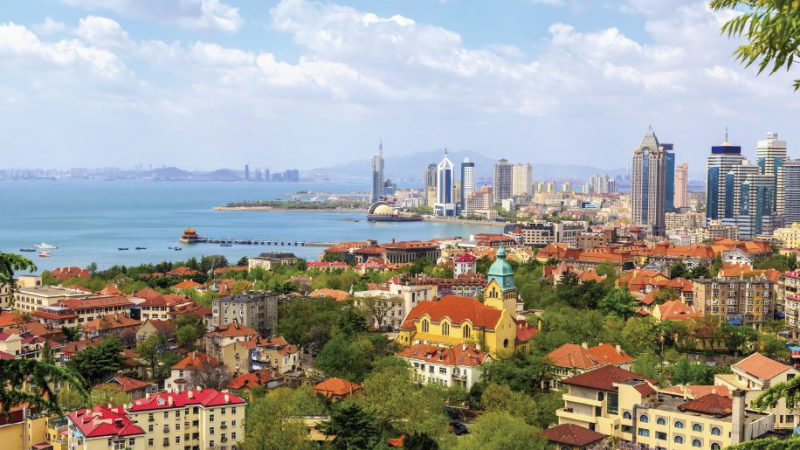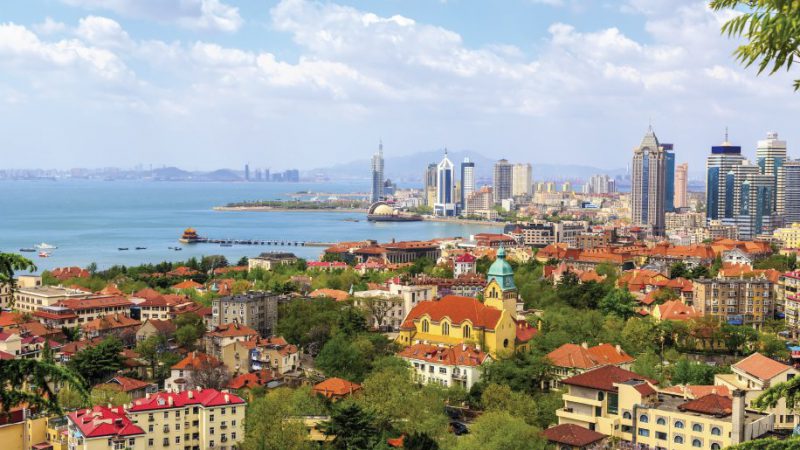Qingdao Fling
December 30, 2018

China can be a daunting destination for any traveler, whether for leisure or business. It is still, in many ways, the sleeping dragon that is just emerging from some 3,000 years of inscrutable history. In China, one is always living in interesting times as the country of nearly 1.4 billion souls gathers forests of cranes and armies of coders to create an ever-burgeoning future of global technologies and light-speed manufacturing capabilities.
The city of Qingdao is one of those cities making the great leap forward from its spot on the eastern coast of the country along the shores of the Yellow Sea. New nonstop service from Los Angeles on Xiamen Airlines is making the city all the more accessible, and it is a mere 90-minute flight from Seoul and 4.5 hours by high-speed rail from the capital of Beijing.
However, Qingdao (formerly spelled Tsingtao – yes, the same Tsingtao of beer fame) has been on the map of western business for more than a century. German and Austrian capitalists found the city perfect for making beer from the many artesian wells that pop up around the geography. To date, popular Tsingtao beer remains one of China’s principal exports.
A tour of the original factory tells a story of European influence, and the neighborhoods that lace the city still bear the neo-modernist touches of the turn of the last century. Mansions and office buildings look like chalets, and wide stone plazas seem set for Euro-style coffee sipping and gathering.
Those pockets of former European grandeur are complemented by centuries-old Taoist temples atop winding and narrow city streets that overlook the Laoshan National Park and then the calm, sheltered beaches of Qingdao. At night Qingdao lights up like Times Square with high rise buildings and unusual sphere sculptures that turn into flowing canvases of LED artistry.
East Meets West
A westerner could feel at home in Qingdao. Shopping malls with Starbuck’s, McDonald’s and local pizza counters vie with stores selling New Balance shoes and Apple products. But this is very much a Chinese city of some 10 million people.
Visitors will find a vibrant metropolis that is as modern and contemporary as it is traditional, where tea houses abound and little English is spoken. For travelers who want to experience the city as a local, Qingdao is wide open. There are few foreign faces there, yet a westerner will receive subtle respect and feel an overwhelming sense of safety. →
That means, however, that communication will always be a conundrum. It is difficult to find guides that approach fluency in English. Still, even with the gaps, much can be communicated and smartphones can be great tools thanks to translation apps.
China Mobile and China Unicom run sim card deals for iPhone and Android users. It may be easier, however, to stay with a US-based international plan to manage e-mail and calls seamlessly. Plus, despite Google, Facebook and many news channels not working in China, there are ways to access these channels in spurts if you use a US-based plan.
Qingdao is easily the most sophisticated destination in the Shandong province of China. Familiar hotel brands include Hilton, Shangri-La, Sheraton, Le Meridian, Westin, Wyndham, Crown Plaza, even Doubletree. These hotels have become a mainstay for business travelers flowing into the city, helping the city’s quest to become Silicon Blue.
Qingdao’s New High-Tech Industrial Zone on the west coast Jiaozhou Bay is seeing large inflows of investment dollars as a new economic zone gaining ground in China. Some five square miles are building up around marine industry research, alternative-energy and new-materials research, plus software services, advanced manufacturing and cloud computing. Haier, a trusted name for household appliances in the west, also has its headquarters in Qingdao.
“This city has much to offer anyone who visits, whether a business traveler or a leisure traveler,” says Qingdao promotion director Yuan Bing. “But business travelers are the ones who are traveling here. They make up 70 percent of the visitor numbers from the US, which is our largest long-haul market.”
Qingdao Scene
Indeed, the city is clean and fresh with a comfortable ocean breeze and a pedestrian walkway along the shore that goes on for miles and miles. Top points of interest include St. Michael’s Church, a circa-1932 Catholic cathedral built in classic neo-gothic tradition where daily mass is still celebrated. The Bookhouse by the church is a former Baroque-style mansion that is now a bookstore, gift shop, and a great place to wander and think.
From there, a visit to the Tsingtao Beer Museum is in order. It’s a multidimensional complex telling the history of the popular beverage with holograms and life-like dioramas, finishing up, happily, in the tasting room. The experience can be followed by lunch at the museum where onion rings, fries and hamburgers can be munched with chop sticks and downed with golden pitchers of the brew.
Shandong Strong
Qingdao is the largest city in Shandong province, one the country’s 23 provinces, a area that has played a major role in early Chinese history along the lower reaches of the Yellow River. It was a location for the development of Taoism, Chinese Buddhism and Confucianism. So any visit to Qingdao should be complemented with a trip to some of Shandong’s other captivating locations, such as the birthplace of Confucius and Mount Tai, a revered mountain for Buddhism and Taoist worship.
Geographically, the province sprawls for some 60,000 square miles (think of the state of Georgia) with nearly 2,000 miles of coastline. It has a mountainous middle and attractive tourism areas given to names such as Fairyland Coast, Affectionate Yimeng and the Oriental Holy Land.
Close to Qingdao (a two- to three-hour drive or two-hour by rail) is the Fairyland Coast of northeast Shandong, which juts out between the Bohai, Huanghai and Yellow seas like a hand. Here the Penglai Pavilion is considered one of the four great pavilions of China. It sits atop Danya Hill, covered by centuries-old Cyprus trees and overlooking the confluence of the waters. The massive gift shop is a good place to buy carvings, exotic fruits and trinkets, and area wines.
Or one can taste the wines at the source. Yantai, on the northern flank of the Fairyland Coast, has become China’s wine capital thanks to the work of Chang-yu Pioneer Wine Company, the country’s oldest and largest winery, in the late 19th Century. The terroir of this region compares to Bordeaux, and the “chateaux” of the region to pour bottles of attention-grabbing cabernets, rieslings and chardonnays.
While the tastes cater to more local preferences, the viticulture in China is catching on for tourism. A tour of the Chang-yu wine museum brings post-tour tastings and a chance to contemplate a room-size model of the new 1,000-acre $870 million Disney-style wine theme park with its palatial chateau, a research institute, wine production and a number of bars and restaurants.
Treasures of the Interior
Farther afield, but very much of interest, is Shandong’s capital, Jinan. It’s a two-hour high-speed train ride from Qingdao (five hours by car). This is a magical city of geothermal mineral waters that bubble up from deep in the earth; it can be enjoyed from gurgling fountains, in tea, in the local cuisine and in spas around the city. Baotu Springs is one of the top water spouts in the city, with pavilions, gardens and peaceful pathways, all in a stunning park setting.
A leisurely moat boat ride around Daming Lake makes a great intro to the city. High-end hotel spas offer geothermal heated swimming pools, saunas, Jacuzzis and massage services. Among these are the Luxury Blue Horizon Hotel, InterContinental Jinan City, the Sheraton Jinan, Swisshotel and Shangri-La Hotel Jinan.
Xiamen Air is offering a complimentary roundtrip ticket to Jinan from Qingdao on China’s high-speed rail line to travelers taking the LAX-DAO nonstop flight. Business Class passengers will enjoy the rail’s 2×2 first-class car service. Coach passengers will ride in coach class with comfortable seats in two by three configurations. →
Jinan makes a great home base for visits to Shandong’s three UNESCO World Heritage sites. Qufu, about two hours from the city is the birthplace of Confucius and features the teacher’s family mansion, temple and family cemetery as the main attractions.
Mt. Tai is an hour and a half drive from Jinan. At 4,635-feet, it is one of the great mountains of China, possibly because it has been a continuous place of worship for more than three millennia. Dai Temple, at the foot of the mountain was first built during the Qin Dynasty (221 BC to 207 BC) and is one of three extant structures in China with the features of an imperial palace (the others: The Forbidden City and the Confucius Temple at Qufu).
The mural paintings here date back to the 10th century and the cypress trees are more than 2,000 years old. The 6,000 granite steps to the top of the mountain may be even older. Visitors can walk the steps or take a cable car to the top. A sunrise ascent is recommended.
The Grand Canal in southern Shandong is best known as the Beijing–Hangzhou Grand Canal linking the Yellow River and Yangtze River. It dates back to the 5th century BC in some parts making it the longest and the oldest canal system in the world.




